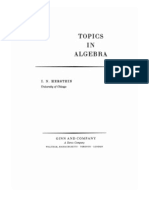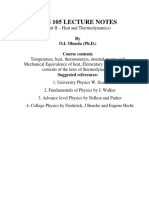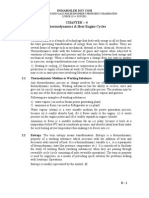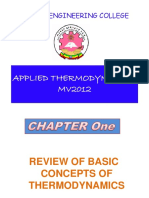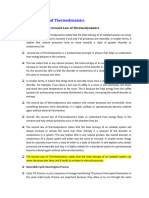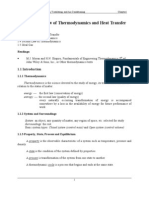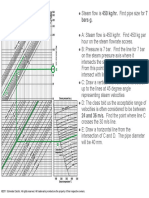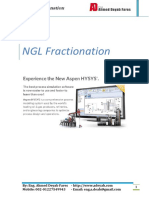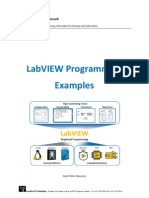Lecture1 2
Lecture1 2
Uploaded by
Ahmad DeyabCopyright:
Available Formats
Lecture1 2
Lecture1 2
Uploaded by
Ahmad DeyabOriginal Description:
Original Title
Copyright
Available Formats
Share this document
Did you find this document useful?
Is this content inappropriate?
Copyright:
Available Formats
Lecture1 2
Lecture1 2
Uploaded by
Ahmad DeyabCopyright:
Available Formats
FundamentalconceptsrelatedtoheatintegrationModuel02
Lecture03
Module No: 02 Fundamental concepts
Lecture-03: Fundamental concepts related to heat integration
Key words: Thermodynamics,Carnotcycle,Qualityofheat,Workpotential,Entropy,
Convectiveheattransfer
This lecture deals with the fundamental concepts required to understand the concept of heat
integration using the principles of process integration and more specifically the Pinch
Technology
2.0Lawsofthermodynamics
Heat integration using Pinch Technology employs extensively the laws of thermodynamics. Thus
a discussion on the first two laws of thermodynamics is included.
2.1 First law of thermodynamics (FLT)
The first law of thermodynamics may be expressed by several forms of the fundamental
thermodynamic relation [3]:
Increase in internal energy of a system = heat supplied to the system + work done on the system
For a thermodynamic cycle the net heat supplied to the system equals the net work done by the
system.
The net change in internal energy is the energy that flows in as heat minus the energy that
flows out as the work that the system performs on its environment. Work and heat are not
defined as separately conserved quantities; they refer only to processes of exchange of
energy.
These statements entail that the energy obeys the principle of conservation of energy.
The principle of conservation of energy may be stated in several ways:
Energy can be neither created nor destroyed. It can only change forms.
However, the concept of energy in the first law does not account for the observation that natural
processes have a preferred direction of progress. For example, spontaneously, heat always flows
to regions of lower temperature, never to regions of higher temperature without external work
being performed on the system. The first law is completely symmetrical with respect to the initial
and final states of an evolving system.
FundamentalconceptsrelatedtoheatintegrationModuel02
Lecture03
2.2 The second law of thermodynamics (SLT)
The second law of thermodynamics distinguishes between reversible and irreversible physical
processes. It shows the existence of a quantity called the entropy of a system, and its change
during a process expresses the irreversibility of actual physical processes by the statement that
the entropy of an isolated macroscopic system never decreases.
The second law of thermodynamics places constraints upon the direction of heat transfer and the
attainable efficiencies of heat engines. In doing so, it goes beyond the limitations imposed by the
first law of thermodynamics. The maximum efficiency which can be achieved is the Carnot
efficiency.
The second law of thermodynamics is a profound principle of nature which affects the way
energy can be used. There are several approaches to stating this principle qualitatively. Here are
some corollaries of SLT.
1. It is impossible for a system to transfer heat from a lower temperature reservoir to a
higher temperature without any external work. Simply, heat transfer can only occur
spontaneously in the direction of temperature decrease.
2. Any system which is free of external influences becomes more disordered with time. This
disorder can be expressed in terms of the quantity called entropy. The entropy of a system is a
measure of the amount of molecular disorder within the system. A system can only
generate, not destroy, entropy. The entropy of a system can be increased or decreased by
energy transports across the system boundary.
3. It is impossible for a system to receive a given amount of heat from a high-temperature
reservoir and provide an equal amount of work output. While a system converting work
to an equivalent energy transfer as heat is possible, a device converting heat to an
equivalent energy transfer as work is impossible. For example, we cannot build a heat
engine that has a thermal efficiency of 100%.
4. A basic corollary of the SLT is the statement that the sum of the entropy changes of a
system and that of its surroundings must always be positive, that is, the universe (the sum
of all systems and surroundings) is constrained to become forever more disordered and to
Proceed towards thermodynamic equilibrium with some absolute maximum value of
entropy.
The natural direction of a change in state of a system is from a state of low probability to one of
higher probability and disordered states are more probable than ordered ones. Thus the natural
direction of change of state of a system is from order to disorder.
HOTBODY
EntropyDecreases
HeatFlow
COLDBODY
EntropyIncreases
Fig.2.1 Heat transfer process from the point of view of entropy
FundamentalconceptsrelatedtoheatintegrationModuel02
Lecture03
Figure 2.1 illustrates a heat transfer process from the entropy point of view. That during a heat
transfer process, the net entropy increases. The SLT requires that the increase in entropy of the
cold body be greater than the decrease in entropy of the hot body. As a matter of fact, the
increase in entropy of the cold body is more than the decrease in the entropy of the hot body and
thus overall entropy increases. The conclusion is that processes can occur only in the direction of
increased overall entropy or molecular disorder.[2]
The SLT is a valuable guide to energy policy as it establishes the relationship between entropy
and the usefulness of energy. Energy is most useful to us when we can get it to flow from one
substance to another, e.g., to warm a house and we can use it to do work.
2.2.1 Carnot Cycle
The purpose of a heat engine,Fig.2.2, is to take heat(QH) from a high-temperature source(TH),
convert some of this to mechanical work, and then reject the rest of the heat energy(Qc) to a
lower-temperature source( sink at Tc). Carnot described heat engines in a crude analogy to
waterwheels. The energy available for conversion in a waterwheel is the gravitational energy
contained in water as it flows from some height (from a dam or mountain lake) down through the
wheel. The amount of energy available depends on the difference in height-the "head" between
the source and the pool below the wheel. The energy available to a heat engine depends on the
"temperature head." Just as a high dam can provide more energy than a low one, a large
temperature difference can provide more energy to be converted by a heat engine than can a
small temperature difference. In the example of a heat engine, the high-temperature reservoir
would be the hot steam coming from the power plant boiler. The low-temperature reservoir to
which the engine (in this case steam turbine) rejects the unconverted energy is the condenser
cooled by circulating water. [2]
Fig.2.2 Carnot Cycle
= W/QH = 1 TC/TH
. (2.1)
Carnot efficiency ( ) is the maximum theoretical efficiency a friction-free heat engine could
have. It's always less than 100% and for real heat engines may be less than 80%. Add friction and
other losses and the actual efficiency is typically less than 50%.
FundamentalconceptsrelatedtoheatintegrationModuel02
Lecture03
2.3Qualityofheatenergyatdifferenttemperatures
The cost of a certain amount of energy is a function of temperature. For example 2000 kJ of
thermal energy at 100 C costs less than same amount of energy at 200C. The readers can find
the logic behind the above statement in thermodynamics. It is a well-known fact and can be
proved through Carnot Cycle Efficiency, Entropy and work potential.
Since the second law of thermodynamics states that not all supplied heat in a heat engine can be
used to do work, the Carnot efficiency limits the fraction of heat that can be used.
The Carnot efficiency, defined as the fraction of the ingoing heat energy that is converted to
available work, is expressed as:
C = (Ti - To) / Ti
. (2.2)
Where;
C = efficiency of the Carnot cycle
Ti = temperature at the engine inlet (K)
To = temperature at engine exhaust (K)
The wider is the range of temperature between Ti and To, the more efficient the cycle is. The
lowest temperature is limited by the temperature of the sink of heat - it can be the atmosphere or
the ocean, river or whatever available [1].
2.3.1 Explanation based on Carnot efficiency
Let us consider that the sink temperature for Carnot cycle is at 298 K( ambient temp. 25C).
Then the Carnot efficiency for the 100C (373 K) hot stream will be equal to 0.201((373298)/373) whereas, Carnot efficiency for 200C (473 K) will be 0.37.
Thus, heat from high temperature heat source (200C) can be converted to work more efficiently
than from the source of 100C.
2.3.2 Explanation based on Entropy
Consider an equal amount of heat energy equal to 2000 kJ is transferred from both the heat
sources having temperatures 100C and 200C. Then the entropy change for the heat source as a
result of transfer of 2000 kJ of heat from the reservoir can be computed as:
S, Entropy for 100C
heat sources = Q/T = 2000/(100+273) = 5.361 kJ/K
S, Entropy for 200C
heat sources = Q/T = 2000/(200+273)= 4.228 kJ/K
Similarly
FundamentalconceptsrelatedtoheatintegrationModuel02
Lecture03
As the entropy of the 200C heat source is less than the 100C heat source the quality of heat
source having 200C is better than 100C.
2.3.3 Explanation based on Work potential
Work potential is the potential of the heat to deliver work output. In other words, if Q is the
quantity of heat supplied at a given temperature T then what is the maximum work that this heat
can produce is the work potential. The maximum work (work potential) is computed by
multiplying Q with Carnot efficiency.
For 100 C sources if Q is 2000 kJ then work potential is = 2000x0.201 = 402 kJ
For 200C source is Q=2000kJ then work potential is = 2000x0.37 = 740 kJ
The heat source which has a higher work potential is termed as better quality heat source. In this
case the 200C heat source is a better quality heat source than a 100C heat source.
Thus, for high temperature sources one always pays more than that for a heat source whose
temperature is lower as high temperature sources are of better quality than the comparative low
temperature sources. Thus with rise in temperature the quality of heat energy improves as can be
seen from Carnot Efficiency, entropy and work potential.
However, it is reverse with refrigeration system as shown in Fig.2.3. For example creation of a 10C cold utility is difficult than creating the -5C cold utility. In other words the more we go
below the ambient temperature, the cost of the cold utility increases. The above facts are
described below:
Heat at -10C has got better work potential as compared to that of heat at -5C. To explain it let
us consider a Carnot Cycle operating between ambient temperature (25 C) and the refrigerated
region temperature -10C as well as -5C.
Ambienttemperature
298K(Source)
Q=2000kJ
Ambienttemperature
298K(Source)
Q=2000kJ
W=201.36kJ
W=234.9kJ
Sinkat268K(5C)
Sinkat263K(10C)
Fig.2.3 Work potential for different low temperature sinks
FundamentalconceptsrelatedtoheatintegrationModuel02
Lecture03
Work potential for (-5C sink) = 2000kJx (1- 268/298) =2000x (1-0.89932) = 201.36
Work potential for (-10C sink) = 2000kJx ( 1- 263/298) =2000x(1-0.88255) = 234.9
As per the second law of thermodynamics heat cant be transferred from a low temperature to
high temperature naturally without work. Thus to create cold utility of 2000 kJ through
refrigeration one has to reverse the cycle and the minimum work required to create a (-10 C cold
utility of 2000 kJ) will be 234.9 kJ where the same for (-5C cold utility of 2000 kJ) will be
201.36. Thus one has to spend more work to create a -10C cold utility of same amount (2000kJ)
than that at -5C as can be seen from Fig.2.4.
Ambienttemperature
298K(Sink)
Q=2000kJ
Ambienttemperature
298K(Sink)
Q=2000kJ
W=201.36kJ
W=234.9kJ
Sourceat268K(5C)
Sourceat263K(10C)
Fig.2.4 Minimum work required to transfer 2000 kJ from different low temperature sources
FundamentalconceptsrelatedtoheatintegrationModuel02
Lecture03
Fig.2.5Qualityofheatenergysources
Fig.2.5 shows that the quality of heat source increases if the temperature of the heat source
increases from ambient temperature. Due to rise in quality of heat source the cost of heat source
also increases for a given amount of heat duty.
However, for refrigerated cold utilities (below ambient temperature) lower is the temperature
greater is the cost of the utility.
Therefore, one should always select the lowest temperature hot utility amongst different hot
utilities available which can meet the requirement. Examples of hot utilities are steam, exhaust
steam, hot oil, etc. For cold utilities (below ambient temperature) highest temperature cold utility
should be selected amongst different cold utilities if it can serve the purpose.
2.4 Heat Transfer across a temperature difference (T)
Selection of a particular temperature difference ( T) to transfer a given amount of heat, Q, out
of several available T values is crucial in heat integration. High value of T in general
decreases the fixed cost of the heat transferring equipment such as heat exchanger but at the same
time degrades the heat to a considerable extent. A discussion in this regard is given below:
FundamentalconceptsrelatedtoheatintegrationModuel02
Lecture03
Example
A heat source at 800 K loses 2000 kJ of heat to a sink at (a) 500 K and (b) 750 K through a
conductor (metal wall as in the case of heat exchanger). Determine which heat transfer process is
more irreversible [2]. In other words in which process the energy is degraded less.
Solution: A sketch of the reservoirs is shown in Fig. 2.6(a) & (b). Both cases involve heat
transfer through a finite temperature difference, and therefore both are irreversible. The
magnitude of the irreversibility associated with each process can be determined by calculating
the total entropy change for each case. The total entropy change for a heat transfer process
involving two reservoirs (a source and a sink) is the sum of the entropy changes of each reservoir
since the two reservoirs form an adiabatic system. The problem statement gives the impression
that the two reservoirs are in direct contact during the heat transfer process. But this cannot be the
case since the temperature at a point can have only one value, and thus it cannot be 800 K on one
side of the point of contact and 500 K on the other side. In other words, the temperature function
cannot have a jump or discontinuity. Therefore, it is reasonable to assume that the two reservoirs
are separated by a partition through which the temperature drops from 800 K on one side to 500
K (or 750 K) on the other side.
800KHotSource
800KHotSource
Entropyentering
Q(2000kJ) (Q/T=2000/800=2.5)
Entropygeneratedin
theconductor
1.5 (= 42.5) kJ/K
Entropyentering
Q(2000kJ) (Q/T=2000/800=2.5)
Entropygeneratedin
theconductor
0.17 (= 2.662.5) kJ/K
Q(2000kJ) Entropyleaving
(Q/T=2000/750=2.67kJ/K)
Entropyleaving
Q(2000kJ) (Q/T=2000/500=4kJ/K)
750KSink
500KSink
(a)
(b)
Fig.2.6(a)and(b)Heatsourceandsinkdiagramsfortheexample
The total entropy change for the process in part b is smaller, and therefore this process is
associated with smaller irreversibility. This is expected since the process in (b) involves a smaller
temperature difference and thus a smaller irreversibility. In other words, quality of energy is
degraded less in case b in comparison to a. Therefore, it can be inferred that if a process can
be carried out under a lower temperature difference then one should not employ high temperature
FundamentalconceptsrelatedtoheatintegrationModuel02
Lecture03
difference to carry out the same process. By doing so, one can save in terms of degradation of
energy.
However, from the point of view of design of heat exchangers, if a process is operating under
higher temperature difference (Large value of T) it will require less heat transfer area to pass a
given amount of heat in comparison to lower value of T. Thus operation at higher value of T
will decrease the fixed cost of heat exchanger at the cost of degradation of energy.
In a process industry the whole industry runs between two temperature levels defined by the hot
utility (which is the hottest) and cold utility. Pictorially this is shown by Fig.2.7.
HOTUTILITY(athighesttemperature)
Tavailable
HOTUTILITY(athighesttemperature)
Tavailable
Process
Industry
Process
Industry
ProcessA
ProcessB
ColdUTILITY(atlowesttemperature)
Fig.2.7Processindustryoperatingundera
temperaturedifferential
ColdUTILITY(atlowesttemperature)
Fig.2.8ProcessA&Bareincludedinthe
heatflowpathunderthesameT
However,theT available for industry is more than it is required, and then more processes can
be included in the path of heat flow as shown in Fig.2.8. In such cases the additional processes
will get a free ride. The process A will operate from the exhaust heat of Process Industry and
process B will operate with the help of exhaust heat of Process A.
Hence, selection of proper T under which a process will operate is very crucial for heat
integration.
2.5ConvectiveHeatTransfer
In a large number of heat exchangers convective heat transfer takes place. The overall heat
transfer coefficient in such exchangers is influenced by the thickness and thermal conductivity of
the mediums through which heat is transferred. The larger is this coefficient, the easier heat is the
transfer of heat from hot fluid to the cold fluid that is being heated. In a heat exchanger, the
FundamentalconceptsrelatedtoheatintegrationModuel02
Lecture03
relationship between the overall heat transfer coefficient (U) and the heat transfer rate (Q) can be
demonstrated by the following equation:
Q = UATLM
(2.3)
Where,
Q = heat transfer rate, W (J/s)
A = heat transfer surface area, m2
U = overall heat transfer coefficient, W/(m2C)
TLM = logarithmic mean temperature difference, C
From this equation we can see that the Q value is directly proportional to U. Assuming the heat
transfer surface and temperature difference remain unchanged, the greater the U value, the
greater the heat transfer rate. In other words, if Q and U are constant then A will decrease with
rise in the value of TLM.
. (2.4)
Though it is true for a heat exchanger, it does not hold good in the case of heat exchanger
network design during heat integration where Q also increases with Tmin. Thus one does not get
the complete benefit of reduction in A due to rise in the value of Tmin.
2.5.1 Heat transfer through a metal wall
.
Fig.2.9 Heat transfer across a plate when fluids are flowing on both sides of it
FundamentalconceptsrelatedtoheatintegrationModuel02
Lecture03
For Fig.2.9, the overall heat transfer coefficient, U, for such a system can be defined as:
(2.5)
Where;
h1 & h2 = convective heat transfer coefficients, W/(m2 C)
L = thickness of the wall, m
k = thermal conductivity, W/(m C)
The convective heat transfer coefficient (h), sometimes referred to as the film coefficient, is often
used when calculating heat transfer between a fluid and a solid. In the case of a heat exchanger,
heat transfer basically occurs from fluid 1 (source of heat) to solid (metal wall) to fluid 2
(product being heated).
2.5.2 Heat Transfer across a pipe when fluids are flowing within the pipe as well as over the
outer surface of pipe.
This situation is more close to shell and tube heat exchangers which are used in Heat Integration
as shown in Fig.2.10.
ColdFluid
TC,h2
TS1
TS2
r1
r2
HotFluid
Th,h1
Th
Heatfluxinthedirectionofradius(q)=(ThTC)/(R1+R2+R3)
R1
TS1
1/(h12r1L)
R2
ln(r2/r1)/(2kL)
R3
TS2
TC
q
1/(h22r2L)
Fig.2.10:Shell&tubeheatexchanger
FundamentalconceptsrelatedtoheatintegrationModuel02
Lecture03
In such a case the U can be defined based on inside area of the tube (Ui) as well as outside area of
the Tube (Uo). For defining Ui and Uo two different equations are used as given below:
Ui = 1/ (1/h1 + (r2-r1) A1/kAln + A1/ (Aoh2))
(2.6)
Uo = 1/ (A2/ (A1h1) + (r2-r1) A2/kAln + 1/h2)
(2.7)
Where;
A1 is the inside area of the tube (2r1L), m2
A2 is the outside area of the tube (2r2L), m2
k is the thermal conductivity of tube wall, W/(mC)
Aln is the log mean area of tube and is denoted by (A2-A1)/ ln (A2/A1)
If r2-r1 is very small then A1 will be approximately equal to A2 and the above equation reduces
to:
Ui = 1/ (1/h1 + 1/h2)
(2.8)
Uo = 1/ (1/h1 + 1/h2)
(2.9)
Thus, there will be no difference in Ui and Uo.
2.3 Thermal driving force in exchangers
Let us consider a heat exchanger in the form of two concentric pipes as shown in Fig. 2.11. The
cold fluid is flowing inside the inner pipe and hot fluid is flowing in countercurrent mode through
the annulus between the two pipes. It represents a true counter current flow.
Fig.2.11Concentricpipeheatexchanger
FundamentalconceptsrelatedtoheatintegrationModuel02
Lecture03
Follwowing assumptions are made for the better undersatnding of the heat transfer process inside
the heat exchanger: a)
b)
c)
d)
There is no phase change in the system
Heat loss from the system to the surrounding is assumed to be negligible.
The process is assumed to be steady state.
Fluid properties as well as overall heat transfer coefficient U is considered as constant.
The temperature variation (along the length) of heat exchanger as a function of enthalpy picked
up( along the length) is shown in Fig.2.12.
Fig.2.12Heattransfer
processinconcentric
pipeheatexchanger
Where;
T1 = (Th2-Tc1) and T2 = (Th1-Tc2.)
The slope of the temperature difference (driving force (T)) line w.r.t. Q axis can be written as:
d (T) / dQ = [(T2 T1) / Q]
(2.10)
Now, for the differential element shown in the figure above, dQ can be written as: -
FundamentalconceptsrelatedtoheatintegrationModuel02
dQ = U* dA* T
Lecture03
(2.11)
Now, substituting value of dQ from equation (2.11) into equation (2.10) will give: d T
U dA T
T T
2.12
On rearranging the above equation, we get
T T
T
2.13
T
Now, on integrating the above equation on both sides, we get
T T
T
2.14
T
Thus,
T T
T
2.15
T
Or,
T T
2.16
T
T
2.17
Or,
Where,
T T
2.18
T
T
Equation 2.17 can also be arranged as follows to obtain the Area required by a individual heat
exchanger or network for a given heat duty and heat transfer coefficient:
2.19
, lower will be the area requirement for the same heat duty and
Thus, higher is the value of
overall heat transfer coefficient.
FundamentalconceptsrelatedtoheatintegrationModuel02
Lecture03
Now, Let us consider two concentric pipe heat exchangers namely HE1 and HE2. HE1 is a
concurrent heat exchanger and HE2 is a countercurrent heat exchanger. Same hot and cold fluids
are flowing in both the exchangers. The details of the two streams are given in table 1: Specifications
Hot Stream
Cold Stream
CP(mCp)
15 kW/ C
Inlet Temperature
300 C
Heat Duty
1500 kW
*Assumption: - The fluid properties are not varying with temperature.
10 kW/C
30 C
1500 kW
Therefore, the output temperature of the hot and cold streams is calculated to be:
Outlet Temperature of Hot stream = inlet temp. - (Q / CP) = 300 (1500 / 15) = 300 100
=200C
Outlettemperatureofcoldstream=inlettemp.+(Q/CP)=30+(1500/10)=30+150
=180C
Therefore,ifwedrawthetemperatureandheatdutydiagramforthetwoheatexchangers,we
gettheFigs.2.13&2.14:
T,C
350
HotFluid
ColdFluid
300
250
T2=1200C
200
150
T1=1700C
100
50
0
0
200
400
600
800
1000
1200
1400
1600
Q,kW
Fig.2.13Temperaturevs.HeatdutydiagramforcountercurrentHE2
FundamentalconceptsrelatedtoheatintegrationModuel02
Lecture03
T,C
350
250
200
100
50
T2=200C
T1=2700C
150
Coldstream
300
Hotstream
200
400
600
800
1000
1200
1400
1600
Q,kW
Fig.2.14Temperaturevs.HeatdutydiagramforcocurrentHE1
Thus, from the above diagram it is clear that in concurrent heat exchanger, the driving force or
(T) decreases along the length and it is very small at the outlet of the heat exchanger. This leads
to a lower effective temperature difference (
and hence higher area requirement compared
to countercurrent heat exchanger where the driving force remains almost constant throughout the
heat exchanger. This will become clear from the following calculations: For HE1,
= (270 20) / ln (270/20)
= 250 / 2.6027 = 96.05 C
Thus,
A = 1500 / (U* 96.054) = 15.6162 / U m2
FundamentalconceptsrelatedtoheatintegrationModuel02
Lecture03
For HE2,
= (170 120) / ln (170 / 120)
= 50 / ln (17/ 12) = 143.55 C
A = 1500 / (U* 143.55) = 10.45 / U m2
Thus,
Also, it should be noted that the outlet temperature of the cold fluid in a concurrent heat
exchanger cannot be higher that the outlet temperature of the hot fluid as this will lead to
temperature cross resulting in very high area requirement. However, in a countercurrent heat
exchanger, the hot stream can be utilized to a temperature lower than the outlet temperature of
the cold stream as evident from Fig. 2.15:
Fig.2.15temperatureprofileofacountercurrentheatexchanger
FundamentalconceptsrelatedtoheatintegrationModuel02
Lecture03
The above discussions corresponds to 11 (1shell pass 1 tube pass) heat exchangers. Many
otherflowarrangementsotherthan11exists,themostcommonofwhichisthe12designas
showninFig.2.16(a&b)alongwithitstemperatureprofile:
Fig.2.16(a) 12ShellandTubeheatexchanger
Fig.2.16(b)Temperatureprofilesofa12ShellandTubeheat
exchanger
From the above diagram, we can see that flow arrangement inside a 1-2 shell and tube heat
exchanger involves part countercurrent and part co-current flow. Therefore the effective
temperature difference for heat exchange is reduced compared to pure counter current heat
exchanger.
FundamentalconceptsrelatedtoheatintegrationModuel02
Lecture03
To accommodate this, FT factor is used in the basic heat exchanger design equation as given
below:
Q = U* A* T* FT
(2.20)
Where,
FT = f (R, P) < 1
=
R (Ratio of two heat capacity flow rate) =
P (Thermal effectiveness of the exchanger) =
2.21
2.21
From Eq. 2.20, we can clearly say that 1 2 design needs a larger area than the 1 1 design.
However, 1 2 design is very common as it offers many practical advantages such as:
a) Allowance for thermal expansion
b) Easy mechanical cleaning
c) Good heat transfer coefficient on tube side due to higher velocity
Thermal Effectiveness of a heat exchanger: - The thermal effectiveness of the heat exchanger
is defined as the ratio of the actual heat transfer to the maximum possible heat transfer.
Thermal effectiveness, P =
(2.22)
The actual heat transfer may be computed by calculating either the energy lost by the hot fluid or
the energy gained by the cold fluid. Thus, for a heat exchanger, the actual heat transfer
q = CPhot * (TH1 TH2) = CPcold * (TC2 TC1)
(2.23)
The maximum possible heat transfer from an exchanger, is possible if one of the fluids has to
undergo a temperature difference equal to the maximum possible temperature difference inside
the exchanger which is the difference between the entering temperatures of the hot and cold
fluids. According to the energy balance equation, the fluid which might undergo this temperature
difference must be the one having minimum value of CP(MCp) as the energy received by one
fluid must be equal to the energy given by the other fluid. Therefore, maximum possible heat
transfer is given by:
Qmax = CPmin * (THinlet TCinlet)
(2.24)
Now, the fluid having minimum CP may either be a hot fluid or a cold fluid depending on the
mass flow rate and specific heats. Thus, the thermal effectiveness(P) may be written as:
Ph = (CPhot * ( TH1 TH2)) / (CPhot* (TH1 TC1))
FundamentalconceptsrelatedtoheatintegrationModuel02
Lecture03
= (TH1 TH2) / (TH1 TC1)
(2.25)
Pc = (CPcold * ( TC2 TC1)) / (CPcold * (TH1 TC1))
(2.26)
= (TC2 TC1) / (TH1 TC1)
(2.27)
Here, the subscripts on the effectiveness symbol designate the fluid which has minimum value of
CP.
Expressions for FT factor
The expression of FT for 1-2 heat exchangers is as follows:
For R 1,
1ln
1 ln
1
1
2.28
For R = 1
2
1
ln
2.29
FundamentalconceptsrelatedtoheatintegrationModuel02
Lecture03
TheshapeofthesefunctionsisshowninFig.2.18
(a)
(b)
(c)
Fig.2.18FTcurvesfor12S&THeatExchanger
From the above diagram, it can be seen that with the decrease in FT, the slope of FT curve for a
given value of R becomes very steep and approaches to a certain value of P asymptotically.
FundamentalconceptsrelatedtoheatintegrationModuel02
Lecture03
Now, three basic situations can be encountered while using 1-2 heat exchangers:
a) Temperature Approach: - The final temperature of the hot stream is higher than the final
temperature of the cold, shown in Figure 2.19 and represented as (a) in the FT diagram
(Fig. 2.18). This is called temperature approach as outlet temperature of hot stream
approaches to the outlet temperature of cold stream. This situation is straightforward to
design, since it can always be accommodated in a single 1 2 shell.
Fig.2.19Temperatureapproachwhenfinaltemperatureofhotstreamis
higherthanthefinaltemperatureofcoldstream
FundamentalconceptsrelatedtoheatintegrationModuel02
Lecture03
b) Temperature Cross: - The outlet temperature of the hot stream is slightly lower than the
outlet temperature of the cold stream, as illustrated in Fig. 2.20 and represented in FT
diagram as point (b) in Fig. 2.18. This is called temperature cross. This situation is
usually straightforward to design, provided the temperature cross is small, as it can be
accommodated in a single shell. However, the decrease in FT which is a function of extent
of temperature cross increases the heat transfer area requirements significantly.
Fig.2.20Temperatureapproachwhenfinaltemperatureofhotstreamislessthan
thefinaltemperatureofcoldstreamshowingasmalltemperaturecross
FundamentalconceptsrelatedtoheatintegrationModuel02
Lecture03
c) Large Temperature cross: As the amount of temperature cross increases, problems are
encountered as illustrated in Fig. 2.21 below and represented in the FT diagram as point (c) in
Fig. 2.18.
Fig.2.21Temperatureapproachwhenfinaltemperatureofhotstreamislessthan
thefinaltemperatureofcoldstreamshowingalargetemperaturecross
In this case, the FT decreases significantly, causing a dramatic increase in the heat transfer
area requirement leading to an infeasible design. Local reversal of heat flow may also be
encountered, which is wasteful in heat transfer area. Thus, for a given R, the design of the
heat exchanger becomes less and less efficient as the asymptotic region of the FT curve is
reached.
The maximum temperature cross that can be tolerated is often set by rules of thumb, for example,
FT > 0.75. It is important to avoid low values of FT because:
1) Low values of FT indicate ineffective use of the heat transfer area.
2) Any uncertainties or inaccuracies in design data will significantly affect the design of heat
exchanger when design is carried out in an area where FT slopes are steep. Further,
operation of Heat Exchanger is these area will be unpredictable.
FundamentalconceptsrelatedtoheatintegrationModuel02
Lecture03
Consequently, to be confident in a design, those parts of the FT chart where slopes are steep
should be avoided, even if FT > 0.75. A simple method to achieve this is based upon the fact that
for any value of R there is a maximum asymptotic value for P, say Pmax, which is achieved when
FT tends to negative infinity as shown in Fig. 2.22 , and is obtained as follows:
FT
Pmax
Pmax
Fig.2.22 DeterminationofPmax
According to Bowman et al (4):
For R 1,
1ln
1 ln
1
1
. 2.30
For R = 1
2
1
ln
. 2.31
The maximum value of P, for any R, occurs as FT tends to negative infinity. From the FT
functions above, for FT to be determinate:1. P < 1
2. RP < 1
FundamentalconceptsrelatedtoheatintegrationModuel02
Lecture03
>0
3.
Condition 3 applies to Equation 3.31 when R = 1. Both Conditions 1 and 2 are always true for a
feasible heat exchange with positive temperature differences.
The fraction in condition 3 is greater than zero in two cases:
a) Either both numerator and denominator are greater than zero.
2
Or,
Or,
1
P<
and P <
b) Or both numerator and denominator are less than zero.
2
Or,
Or,
1
P>
2
2
and P >
For Condition 3, either a or b are true but not both. Let us consider condition b in more
detail. For positive values of R,
1 is a continuously increasing function of R, and
As R 0, (R + 1 R2
As R , (R + 1 R2
1) 0
1) 1
For determination of limit as R, multiply and also divide (R + 1 R2
(R + 1 + R2 1),
R
R2
R
=
=
1 R
1
R2
R2
Now, dividing both the numerator and denominator by R, we get
2
1
1) by its conjugate
FundamentalconceptsrelatedtoheatintegrationModuel02
Now, if R, (R + 1 R2
1)
Lecture03
=1
Letusconsiderconditionb,
Since, we know that for positive value of R,
1
1>
Thus,
2
2
1
Thus,
If P >
And for P >
2
1
2
1
, for positive values of R (for Condition b to apply), P > 2
1
1 is always positive and less than 1 for positive values of R
as, R+1 -
, then P will be >
and thus
is always greater than 2.
1
However, P < 1 for feasible heat exchange. Thus, Condition b does not apply for the design of
feasible heat exchangers.
Now let us consider Condition a,
Again, we know that for positive value of R,
1
1>
Thus,
2
2
1
Thus,
If, P <
, then, P, will be <
Hence, both inequalities for Condition a are satisfied when
FundamentalconceptsrelatedtoheatintegrationModuel02
Lecture03
P<
Thus, the maximum value of P(Pmax) for any value of R, is given by:
. (2.32)
Pmax =
However, practical designs will be limited to some fraction of Pmax, that is:
P = XP Pmax,
where, 0 <XP < 1
Where, XP is a constant defined by the designer.
A line of constant XP is compared with a line of constant FT in the Fig. 2.22. It can be seen that
the line of constant XP avoids the regions of steep slope.
Fig.2.23LineofconstantXPinFTdiagram
Situations are often encountered where the design is infeasible in a 1 2 shell and tube
exchanger,becausetheFTistoolowortheFTslopetoolarge.Ifthishappens,eitherdifferent
typesofshellormultipleshellarrangementsmustbeconsidered.Forexamplebyusingtwo1
FundamentalconceptsrelatedtoheatintegrationModuel02
Lecture03
2 shells in series, the temperature cross in each individual shell is reduced below that for a
single12shellforthesameduty.ThiswillbecomeclearerfromtheFig.2.24andFig.2.25.
Toillustratethis,letusconsiderashell&tube(12)heatexchangershownbelowwithits
TemperatureEnthalpyandTemperatureLengthdiagram.
Temperature(0C)
Temperature(0C)
Hot
Cold
(a)
Enthalpy
(b)
Length
TemperatureCrosslarge
Fig.2.24Temperatureprofileofa12 S&Theatexchangerasafunctionofenthalpy(a)aswellas
length(b)
From the Temperature Enthalpy diagram, it is clear that the outlet temperature of the cold
stream is much higher than the outlet temperature of the hot stream. So, the temperature
cross is large as evident from Temperature Length diagram. Therefore, this design is not
feasible.
Now,ifweconsider2numbersofshell&tube(12)heatexchangersinserieshavingEnthalpy
H1andH2suchthat
H1+H2=H
FundamentalconceptsrelatedtoheatintegrationModuel02
Lecture03
This arrangement mimics a two shell pass and four tube pass(24) heat exchanger. The
TemperatureEnthalpyandTemperatureLengthdiagramforsuchasystemisshownbelow:
Temperaturecross
Temperature(0C)
Temperature(0C)
H2
H1
H2
H1
Enthalpy
Length
Fig.2.25Temperaturecrossintwo S&T(12)heatexchangerskeptinseries
Thus,fromaboveTemperatureEnthalpydiagram,itisclearthatthereisnotemperaturecross
inHeatexchangerwithdutyH1andalsothetemperaturecrossinheatexchangerwithdutyH2
ismuchsmallerthanthesingleheatexchangerwithdutyHshownearlier.Thus,wecansafely
saythatputtingshellsinseriesreducesthetemperaturecrossinindividualexchangers.Thisis
clearerfromtheFig.2.25theTemperatureLengthdiagramfortwoshellsinseriescase.
TheconceptofHRATandEMAT
TheDoubleTemperatureApproach(DTA)requirestheselectionoftwoapproachtemperatures
for synthesis of HEN[9]. These temperatures are called the Heat Recovery Approach
Temperature (HRAT) and the Exchanger Minimum Approach Temperature(EMAT). This
approach differs from the work of Linnhoff and Flower[10] as well as similar works where
authorshavetakenasingledirectvariableasTmin.
HeatRecoveryApproachTemperature(HRAT):Theheatrecoveryapproachtemperatureisthe
minimum approach temperature between the hot and cold composite curves as shown in
Fig.2.26. For a given value of HRAT the minimum hot and cold utility consumption for the
problemcanbeestimatedeitherusingcompositecurvesorproblemtablealgorithm.
Exchanger Minimum Approach Temperature(EMAT): Exchanger Minimum Approach
Temperature is the minimum of the exchanger approach temperatures within the network of
process exchangers. The exchanger approach temperature is the minimum temperature of
approachwithinasingleexchanger.Thisminimumvaluecantakeplaceatanyplacealongthe
FundamentalconceptsrelatedtoheatintegrationModuel02
Lecture03
lengthoftheheatexchangernotinvariablyattheextremeendsoftheheatexchangerasshown
inFig.2.27.
T,C
TH
EMAT
T,C
TC
QHmin
TH
Hotcomposite
EMAT
HRAT
TC
Coldcomposite
TH
EMAT
TC
QCmin
H,kW
Fig.2.26HotandcoldcompositecurveswithHRAT
H,kW
Fig.2.27 THdiagramforexchangerswithEMAT
The relationship between HRAT and EMAT is such that, for a given value of HRAT, a network
cannotbedesignedinwhichEMATisgreaterthanHRAT.However,EMATcanbeselectedequal
orlessthanHRATforHENsynthesis.
References:
1. Chemical process design & integration, Robin Smith, John Wiley & Sons Ltd., 2005
2. Heat Transfer, J. P. Holman, McGraw-Hill publication, International student edition,
1986.
3. Ahmad S (1985) Heat Exchanger Networks: Cost Trade-offs in Energy and Capital,
PhD Thesis, UMIST, UK.
4. Bowman RA, Mueller AC and Nagle WM (1940) Mean Temperature Differences in
Design, Trans ASME, 62: 283.
5. Process heat transfer, D. Q. Kern, McGraw-Hill, International student edition, 1983
6. http://www.diclib.com/cgi-bin/d1.cgi?l=en&base=en_st_electrical&page=showid&
id=983
7. Ibrahim Dincer and Yunus A. Cengel , Energy, Entropy and Exergy Concepts and
Their Roles inThermal Engineering, Entropy 2001, 3, 116-149
8. http://en.wikipedia.org/wiki/Laws_of_thermodynamics
9. Colbert R.W., Industrial heat exchange network, CEP July 1982, 47-54
10. Linnhoff, B. and J.R.Flower, AICHE J, 24(4), 633(1978)
You might also like
- Topics in Algebra HersteinDocument349 pagesTopics in Algebra HersteinViplov Jain100% (12)
- Introduction Aspen AdsorptionDocument191 pagesIntroduction Aspen AdsorptionAhmad Deyab100% (2)
- BA4101 - Statistics - For - Management All - Units - Two - Mark's - Questions - and AnswersDocument46 pagesBA4101 - Statistics - For - Management All - Units - Two - Mark's - Questions - and AnswersHaresh k100% (2)
- Meaning of Flooding, Weeping, FoamingDocument1 pageMeaning of Flooding, Weeping, FoamingAhmad DeyabNo ratings yet
- Column Flooding CalculationsDocument6 pagesColumn Flooding CalculationsAhmad DeyabNo ratings yet
- Stress Application ExampleDocument5 pagesStress Application Exampletemestruc71No ratings yet
- Question Bank No 1. For First MCQDocument22 pagesQuestion Bank No 1. For First MCQUnknown Laapta81% (16)
- Energy Conversion and Heat EnginesDocument17 pagesEnergy Conversion and Heat EnginesHarsa RizanoNo ratings yet
- Phs 105 Lecture Notes: by O.I. Olusola (PH.D.) Course ContentsDocument7 pagesPhs 105 Lecture Notes: by O.I. Olusola (PH.D.) Course ContentsDorego TaofeeqNo ratings yet
- Laws of ThermoDocument28 pagesLaws of ThermoRavi ParkheNo ratings yet
- Model-2 and 3 Notes-17-07-2024Document29 pagesModel-2 and 3 Notes-17-07-2024kikidoyouloveme2111No ratings yet
- Aerothermodynamics Thermodynamics LaboraDocument13 pagesAerothermodynamics Thermodynamics LaboraKay-C De LeonNo ratings yet
- Btd Bme304 Module 3Document34 pagesBtd Bme304 Module 3mahesh neethikereNo ratings yet
- CH-4 Thermodynamics Heat Engine CyclesDocument19 pagesCH-4 Thermodynamics Heat Engine CyclessunitbhaumikNo ratings yet
- Lecture 3 ThermodynamicsDocument54 pagesLecture 3 Thermodynamicstorawe6575No ratings yet
- Module 2Document76 pagesModule 2Raj KamalNo ratings yet
- Law of ThermodynamicsDocument18 pagesLaw of ThermodynamicsJOYCE ALIWALASNo ratings yet
- Accepted Manuscript: Applied Thermal EngineeringDocument24 pagesAccepted Manuscript: Applied Thermal EngineeringAnkit Lonare100% (1)
- Power Cycle, Oil, Coal and Natural Gas Introduction To The Rankine Steam Cycle and Carnot EfficiencyDocument69 pagesPower Cycle, Oil, Coal and Natural Gas Introduction To The Rankine Steam Cycle and Carnot EfficiencyLenin PaudelNo ratings yet
- Heat Pump and RefrigeratorDocument10 pagesHeat Pump and RefrigeratorimPERFECTme09No ratings yet
- Defence Engineering College: Applied Thermodynamics MV2012Document38 pagesDefence Engineering College: Applied Thermodynamics MV2012Getachew TikueNo ratings yet
- Chap - 5 Second Law of Thermodynamics - Lectureand Pro 2Document41 pagesChap - 5 Second Law of Thermodynamics - Lectureand Pro 2Mulugeta WoldeNo ratings yet
- Basic mechanical engineering vvi.Document1 pageBasic mechanical engineering vvi.Manish KumarNo ratings yet
- ThermodynamicsDocument12 pagesThermodynamicsSoham NagNo ratings yet
- Second Law (Autosaved)Document32 pagesSecond Law (Autosaved)thakurbikram151No ratings yet
- UNIT 3 ThermodynamicsDocument40 pagesUNIT 3 ThermodynamicsHimadhar SaduNo ratings yet
- JJ207 Thermodynamic Topic 4 Second Law of ThermodynamicsDocument15 pagesJJ207 Thermodynamic Topic 4 Second Law of ThermodynamicsAh TiangNo ratings yet
- Kimia Lingkungan: Bagian 2: TermodinamikaDocument28 pagesKimia Lingkungan: Bagian 2: TermodinamikaAlphanto ToureNo ratings yet
- Laws of ThermodynamicsDocument11 pagesLaws of ThermodynamicssamiNo ratings yet
- Thermo PPT 2 ShareDocument67 pagesThermo PPT 2 ShareAkosua KwakyewaaNo ratings yet
- القانون الثاني للثرموداينمكDocument16 pagesالقانون الثاني للثرموداينمكAli AbdNo ratings yet
- 63960Document31 pages63960amdevaNo ratings yet
- Derivation of Thermodynamic Temperature: N. (Abbr. Abs)Document3 pagesDerivation of Thermodynamic Temperature: N. (Abbr. Abs)ashokNo ratings yet
- The Second Law of ThermodynamicsDocument28 pagesThe Second Law of Thermodynamicswal'aansoo dhokataaNo ratings yet
- Mid Sem Answer Sheet ThermoDocument9 pagesMid Sem Answer Sheet ThermoMadhanRavNo ratings yet
- Carnot's Theorem (Thermodynamics) - WikipediaDocument20 pagesCarnot's Theorem (Thermodynamics) - WikipediaEndhy Wisnu NovindraNo ratings yet
- 2021 ThermodynamicDocument7 pages2021 ThermodynamicChampika V SamarasighaNo ratings yet
- 2nd LawDocument51 pages2nd LawS S S REDDYNo ratings yet
- Unit 1Document37 pagesUnit 1Renjith KrishnanNo ratings yet
- Second Law of Thermodynamics Week - 4 - : Dastan KhalidDocument24 pagesSecond Law of Thermodynamics Week - 4 - : Dastan Khalidaya khazrajiNo ratings yet
- All RAC-pages-pagesDocument90 pagesAll RAC-pages-pagesgalataataaddesaaNo ratings yet
- Carnot's Theorem (Thermodynamics) - WikipediaDocument4 pagesCarnot's Theorem (Thermodynamics) - WikipediaBhuvanesh BalaNo ratings yet
- Comprehensivevivanote 241006171916 816e9d62Document32 pagesComprehensivevivanote 241006171916 816e9d62torvai420No ratings yet
- Engineering Thermodynamics: (T C, M C)Document13 pagesEngineering Thermodynamics: (T C, M C)ragunath LakshmananNo ratings yet
- Engg ThermodynamicsTwo Mark With AnswerDocument16 pagesEngg ThermodynamicsTwo Mark With AnswervelavansuNo ratings yet
- The Second Law of Thermodynamics: Report AboutDocument16 pagesThe Second Law of Thermodynamics: Report AboutCutie PieNo ratings yet
- Basic Thermodynamic For Power Plant OperationDocument65 pagesBasic Thermodynamic For Power Plant Operationmag2grin100% (2)
- (Ebook) Fundamentals HvacDocument183 pages(Ebook) Fundamentals HvacRene VillaNo ratings yet
- Fundamentals HVACDocument183 pagesFundamentals HVACbookslover1No ratings yet
- ExergyDocument8 pagesExergyChandrakant PrajapatNo ratings yet
- Energy Conversion and Rural Electrification1Document43 pagesEnergy Conversion and Rural Electrification1Getahun Shanko KefeniNo ratings yet
- thẻmodynamicDocument8 pagesthẻmodynamicvanvui10No ratings yet
- Lec2 Heat Engine and Carnot Cycle PostDocument51 pagesLec2 Heat Engine and Carnot Cycle PostAniruddha NarkhedeNo ratings yet
- Why Thermal Power Plants Have A Relatively Low EfficiencyDocument8 pagesWhy Thermal Power Plants Have A Relatively Low Efficiencyjiwani87No ratings yet
- Thermodynamics Blue Prints ObjectivesDocument18 pagesThermodynamics Blue Prints Objectivesdawit solomonNo ratings yet
- MEC544 Lecture Notes 2022 1 IntroductionDocument19 pagesMEC544 Lecture Notes 2022 1 Introductionmilt80No ratings yet
- Outcome_1T2Document45 pagesOutcome_1T2Thu Han TunNo ratings yet
- Second Law of ThermodynamicsDocument14 pagesSecond Law of ThermodynamicsEmptySilenceNo ratings yet
- “Foundations to Flight: Mastering Physics from Curiosity to Confidence: Cipher 4”: “Foundations to Flight: Mastering Physics from Curiosity to Confidence, #4From Everand“Foundations to Flight: Mastering Physics from Curiosity to Confidence: Cipher 4”: “Foundations to Flight: Mastering Physics from Curiosity to Confidence, #4Rating: 5 out of 5 stars5/5 (1)
- Thermodynamic analysis of geothermal heat pumps for civil air-conditioningFrom EverandThermodynamic analysis of geothermal heat pumps for civil air-conditioningRating: 5 out of 5 stars5/5 (2)
- Advancements in Mechanical Engineering: Innovating at the Convergence of TechnologiesFrom EverandAdvancements in Mechanical Engineering: Innovating at the Convergence of TechnologiesNo ratings yet
- Valves: 1 - Gate 2 - Plug 3 - Globe 4 - Ball 5 - Butterfly 6 - Diaphragm 7 - Pinch 8 - Relief 9 - CheckDocument1 pageValves: 1 - Gate 2 - Plug 3 - Globe 4 - Ball 5 - Butterfly 6 - Diaphragm 7 - Pinch 8 - Relief 9 - CheckAhmad DeyabNo ratings yet
- Plate Heat ExchangerDocument1 pagePlate Heat ExchangerMohamed FathyNo ratings yet
- Sherwood/Leva/Eckert GPDC Pressure Drop Correlation For PackingDocument3 pagesSherwood/Leva/Eckert GPDC Pressure Drop Correlation For PackingAhmad Deyab100% (1)
- Compressors CLASSIFICATIONDocument1 pageCompressors CLASSIFICATIONAhmad DeyabNo ratings yet
- Area Tolerance & NFP Diam FactorDocument1 pageArea Tolerance & NFP Diam FactorAhmad DeyabNo ratings yet
- LinkedIn-Pump Vendor Data Sheet and Curve PDFDocument9 pagesLinkedIn-Pump Vendor Data Sheet and Curve PDFBehnaz Motamed100% (1)
- Basic Instrumentation Measuring Devices and Basic Pid ControlDocument125 pagesBasic Instrumentation Measuring Devices and Basic Pid ControlCuong Nguyen ChiNo ratings yet
- Active Energy Efficiency Using Speed ControlDocument25 pagesActive Energy Efficiency Using Speed ControlAhmad DeyabNo ratings yet
- Combined Heat and PowerDocument19 pagesCombined Heat and PowerAhmad DeyabNo ratings yet
- Steam Velocity Chart ExampleDocument2 pagesSteam Velocity Chart ExampleAhmad Deyab100% (1)
- Performance of Centrifugal PumpsDocument52 pagesPerformance of Centrifugal Pumpsvisitabhinav100% (4)
- ATM CDU Distillation in Aspen HYSYS V10Document27 pagesATM CDU Distillation in Aspen HYSYS V10Ahmad Deyab100% (2)
- Advanced Process Control-HYSYSDocument27 pagesAdvanced Process Control-HYSYSAhmad DeyabNo ratings yet
- TEG With HysysDocument2 pagesTEG With HysysAhmad DeyabNo ratings yet
- Best Practice Guide For EE ProjectsDocument45 pagesBest Practice Guide For EE ProjectsAhmad DeyabNo ratings yet
- Reports in HysysDocument6 pagesReports in HysysAhmad DeyabNo ratings yet
- Grasses As EnergyDocument134 pagesGrasses As EnergyAhmad DeyabNo ratings yet
- NGL Fractionation Using HYSYSDocument30 pagesNGL Fractionation Using HYSYSAhmad Deyab100% (3)
- Dynamics Quick Guide BetaDocument15 pagesDynamics Quick Guide BetaCHANADASNo ratings yet
- JEE 2009 Paper 1Document17 pagesJEE 2009 Paper 1Animesh MishraNo ratings yet
- EGMO PrefaceDocument2 pagesEGMO PrefaceShu Shujaat LinNo ratings yet
- HW1 FinalDocument4 pagesHW1 FinalVino WadNo ratings yet
- Randomized Block Design MethodDocument15 pagesRandomized Block Design MethodSharath Kumar RNo ratings yet
- Developing Mathematical Problem Solving Skills With Interactive Problem Based Learning and Discovery LearningDocument10 pagesDeveloping Mathematical Problem Solving Skills With Interactive Problem Based Learning and Discovery LearningHanafi AsnanNo ratings yet
- MYP 3 Criterion B-RustingDocument5 pagesMYP 3 Criterion B-Rustingwama ojha67% (3)
- Design VerificationDocument16 pagesDesign VerificationPraveen KethipalliNo ratings yet
- Section 5.4 Accumulation PointsDocument12 pagesSection 5.4 Accumulation PointsPooja Sinha100% (1)
- 15EE103 Analysis of Electric CircuitsDocument2 pages15EE103 Analysis of Electric CircuitsDhruv KhuranaNo ratings yet
- Staad - Pro V8iDocument42 pagesStaad - Pro V8iMayolites0% (1)
- Relational AlgebraDocument58 pagesRelational Algebravaibhav singhNo ratings yet
- Pentaho Advanced Reporting GuideDocument64 pagesPentaho Advanced Reporting GuideDániel TodorovityNo ratings yet
- LabVIEW Programming ExamplesDocument23 pagesLabVIEW Programming Examplesayeshabanu_momin0% (1)
- Chapter 5Document2 pagesChapter 5Ananthan RameshNo ratings yet
- Lecture Notes 6 5510Document55 pagesLecture Notes 6 5510Chentao YueNo ratings yet
- Using Heuristic Strategies To Promote Mathematics Problem Solving Ability of Grade 10 StudentsDocument17 pagesUsing Heuristic Strategies To Promote Mathematics Problem Solving Ability of Grade 10 StudentsGlobal Research and Development Services100% (1)
- Some Mixed Finite Element Method For Biharmonic EquationDocument45 pagesSome Mixed Finite Element Method For Biharmonic EquationBishnu LamichhaneNo ratings yet
- Problem Solving and Reasoning 1Document18 pagesProblem Solving and Reasoning 1Lester ValenciaNo ratings yet
- PDF Electric Circuits 10th Ed 10th Edition James W. Nilsson DownloadDocument84 pagesPDF Electric Circuits 10th Ed 10th Edition James W. Nilsson Downloadterzanliliya6067% (3)
- Market Sentiment and Stock Market Volatility: Evidence From Tehran Stock ExchangeDocument21 pagesMarket Sentiment and Stock Market Volatility: Evidence From Tehran Stock Exchangerenuka sharmaNo ratings yet
- Matlab Is A Programming Language Developed by Mathworks. It Started Out As A Matrix Programming Language Where Linear Algebra Programming Was SimpleDocument29 pagesMatlab Is A Programming Language Developed by Mathworks. It Started Out As A Matrix Programming Language Where Linear Algebra Programming Was SimpleLakshmi malladiNo ratings yet
- Circumcenter Exit TicketDocument1 pageCircumcenter Exit Ticketapi-385151170No ratings yet
- Exm 2017Document16 pagesExm 2017Stuff NewsroomNo ratings yet
- Bezier and B-Spline TechniquesDocument58 pagesBezier and B-Spline TechniquesPranav GujarNo ratings yet
- Name: Fitrah Al Amir Class: PBI D A) Hello! and Welcome To This Recording Brought To YouDocument4 pagesName: Fitrah Al Amir Class: PBI D A) Hello! and Welcome To This Recording Brought To YouFitrah AlAmirNo ratings yet
- MathematicsDocument11 pagesMathematicsHisoka RyugiNo ratings yet
